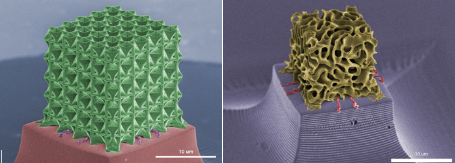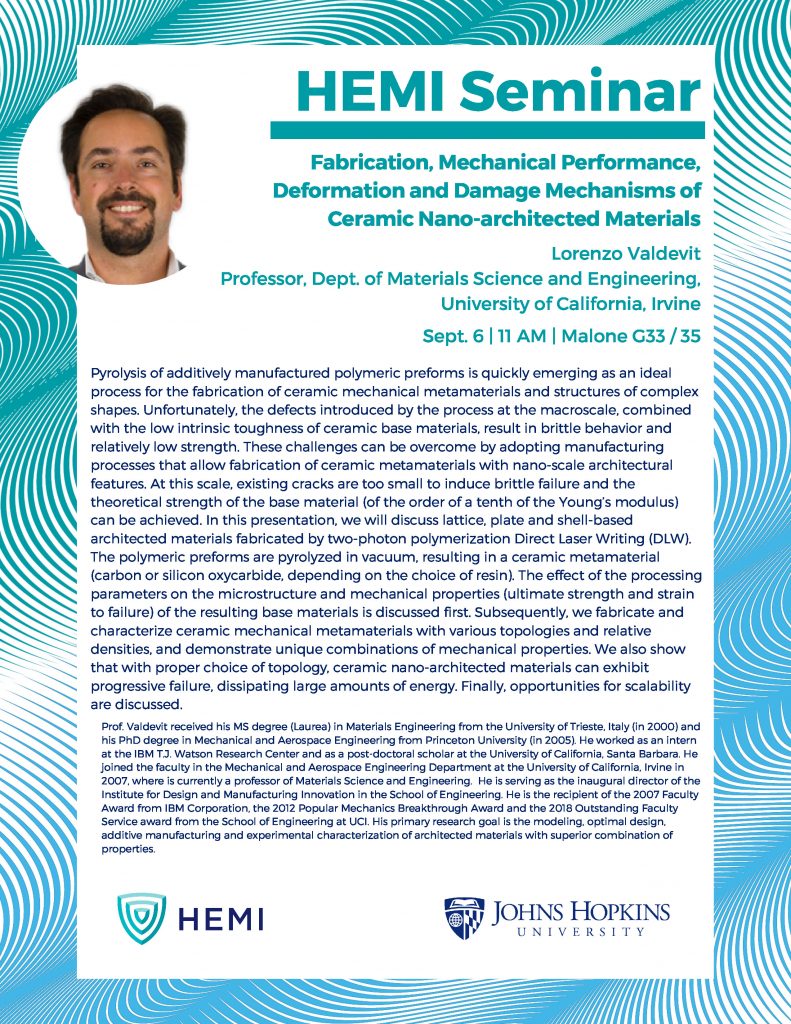September 6, 2019 @ 11:00 am - 12:00 pm
Fabrication, Mechanical Performance, Deformation and Damage Mechanisms of Ceramic Nano-architected Materials
Prof. Lorenzo Valdevit
Department of Materials Science and Engineering, University of California, Irvine
Pyrolysis of additively manufactured polymeric preforms is quickly emerging as an ideal process for the fabrication of ceramic mechanical metamaterials and structures of complex shapes. Unfortunately, the defects introduced by the process at the macroscale, combined with the low intrinsic toughness of ceramic base materials, result in brittle behavior and relatively low strength. These challenges can be overcome by adopting manufacturing processes that allow fabrication of ceramic metamaterials with nano-scale architectural features. At this scale, existing cracks are too small to induce brittle failure and the theoretical strength of the base material (of the order of a tenth of the Young’s modulus) can be achieved. In this presentation, we will discuss lattice, plate and shell-based architected materials fabricated by two-photon polymerization Direct Laser Writing (DLW). The polymeric preforms are pyrolyzed in vacuum, resulting in a ceramic metamaterial (carbon or silicon oxycarbide, depending on the choice of resin). The effect of the processing parameters on the microstructure and mechanical properties (ultimate strength and strain to failure) of the resulting base materials is discussed first. Subsequently, we fabricate and characterize ceramic mechanical metamaterials with various topologies and relative densities, and demonstrate unique combinations of mechanical properties. We also show that with proper choice of topology, ceramic nano-architected materials can exhibit progressive failure, dissipating large amounts of energy. Finally, opportunities for scalability are discussed.
Figure 1: Examples of plate and shell-based ceramic nano-architected materials with unique combinations of mechanical properties
Prof. Valdevit received his MS degree (Laurea) in Materials Engineering from the University of Trieste, Italy (in 2000) and his PhD degree in Mechanical and Aerospace Engineering from Princeton University (in 2005). He worked as an intern at the IBM T.J. Watson Research Center and as a post-doctoral scholar at the University of California, Santa Barbara. He joined the faculty in the Mechanical and Aerospace Engineering Department at the University of California, Irvine in 2007, where is currently a professor of Materials Science and Engineering. He is serving as the inaugural director of the Institute for Design and Manufacturing Innovation in the School of Engineering. He is the recipient of the 2007 Faculty Award from IBM Corporation, the 2012 Popular Mechanics Breakthrough Award and the 2018 Outstanding Faculty Service award from the School of Engineering at UCI. His primary research goal is the modeling, optimal design, additive manufacturing and experimental characterization of architected materials with superior combination of properties.






